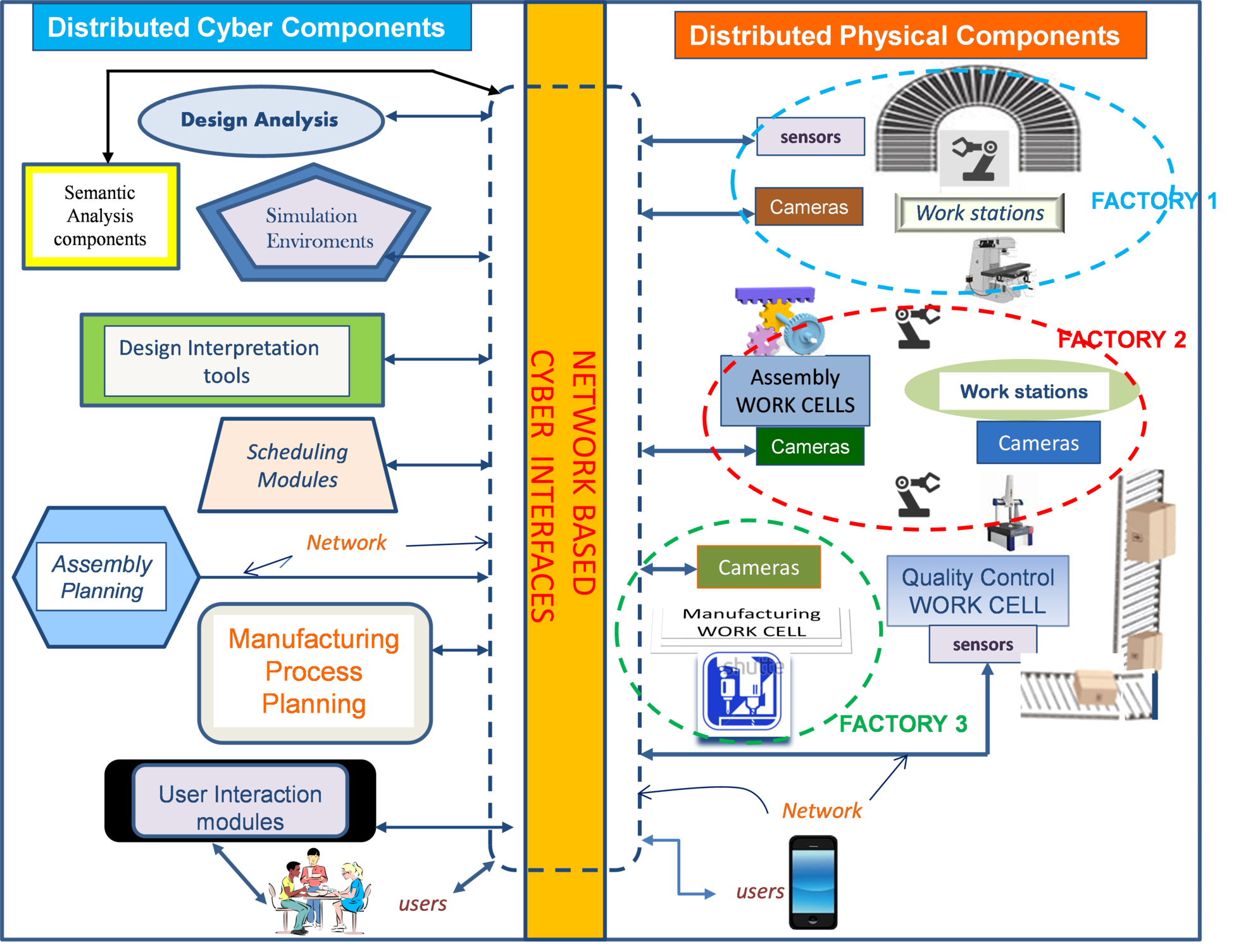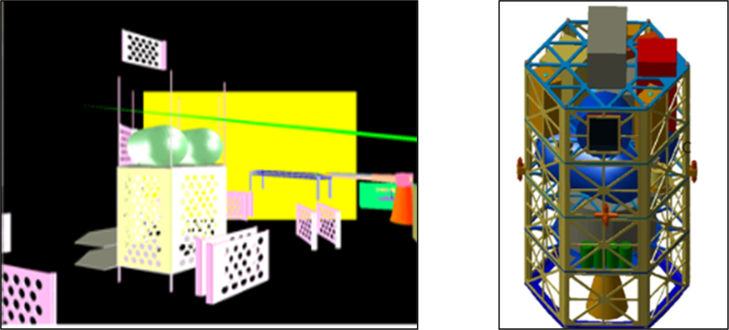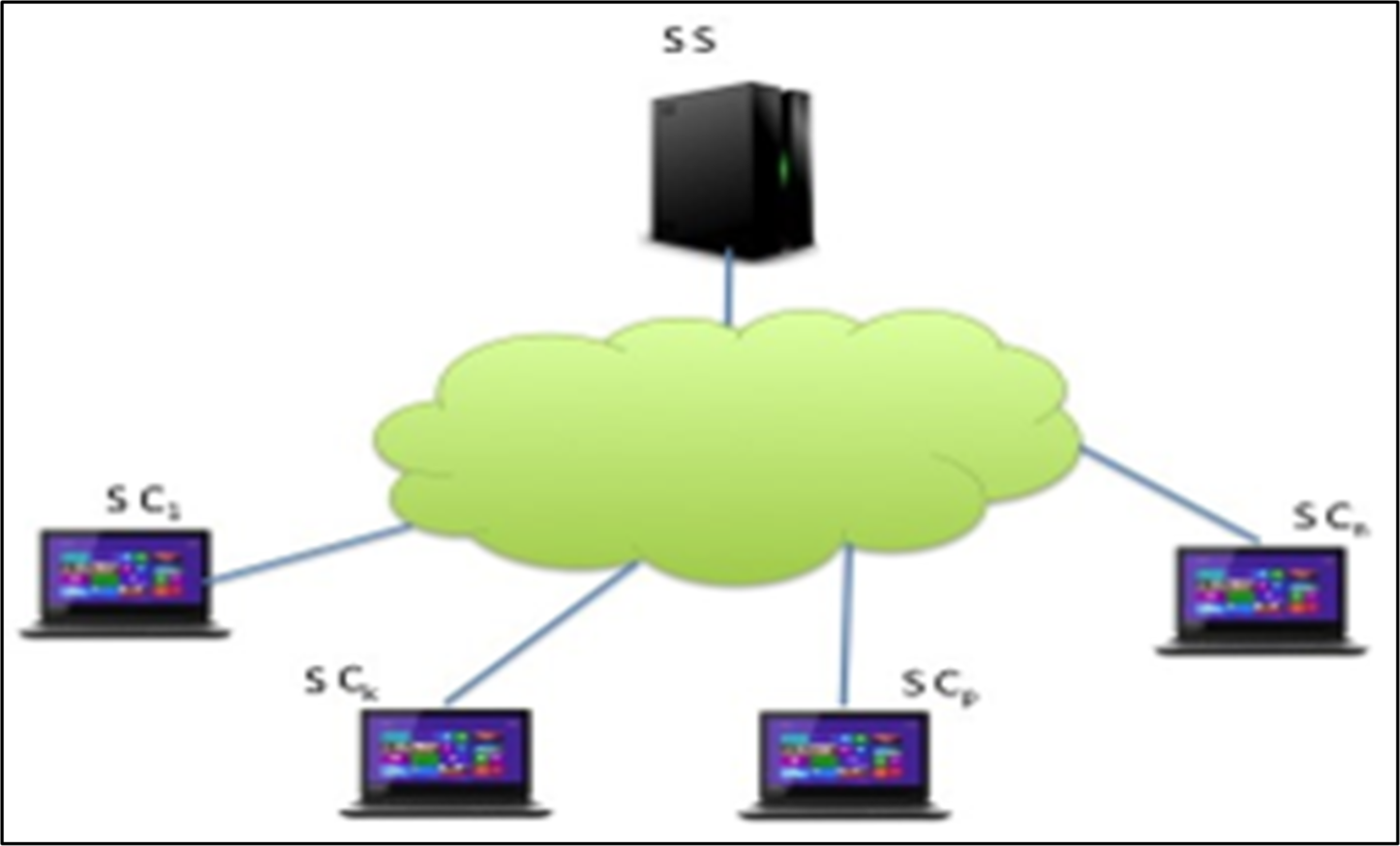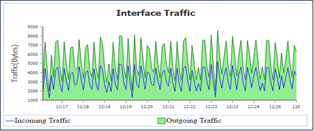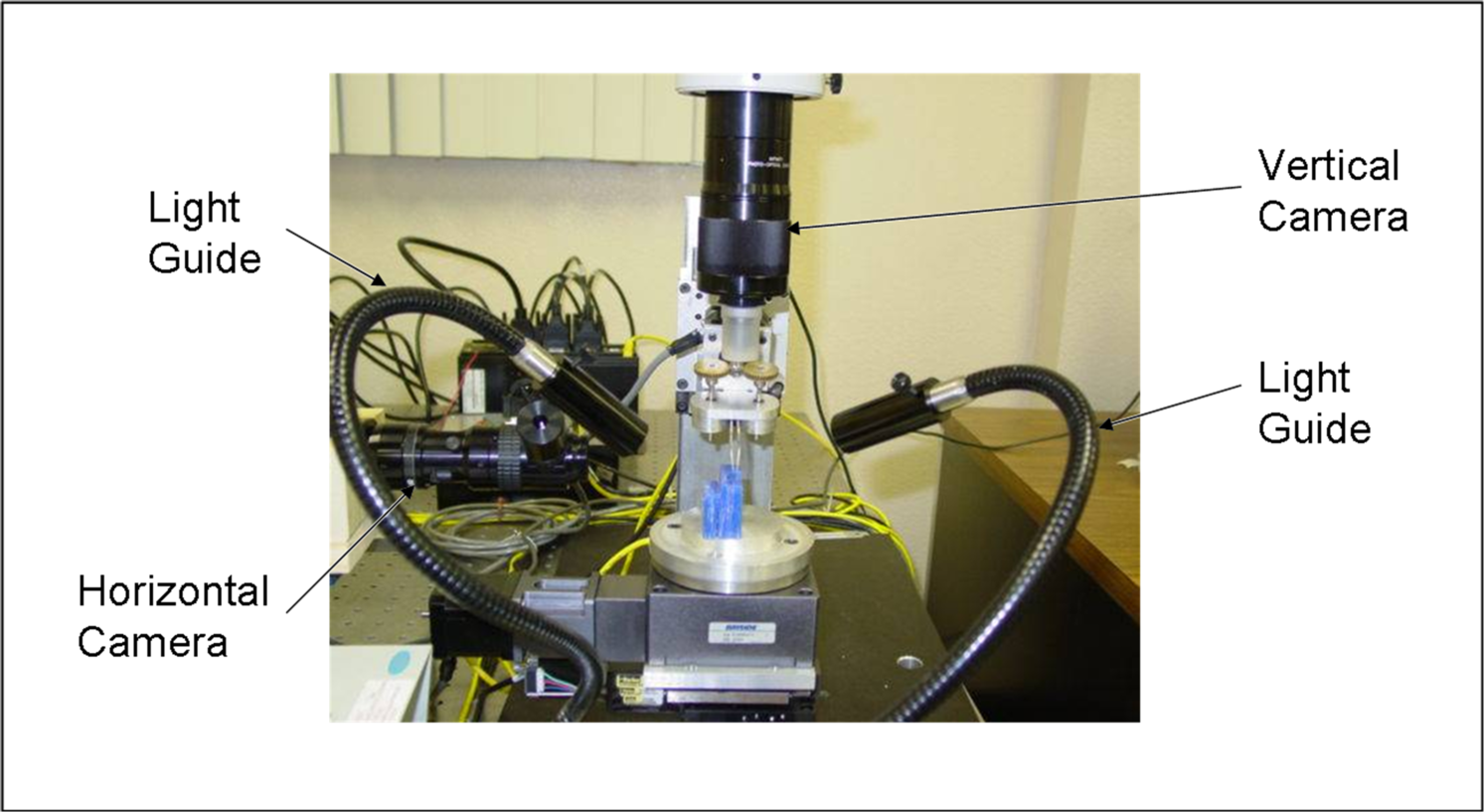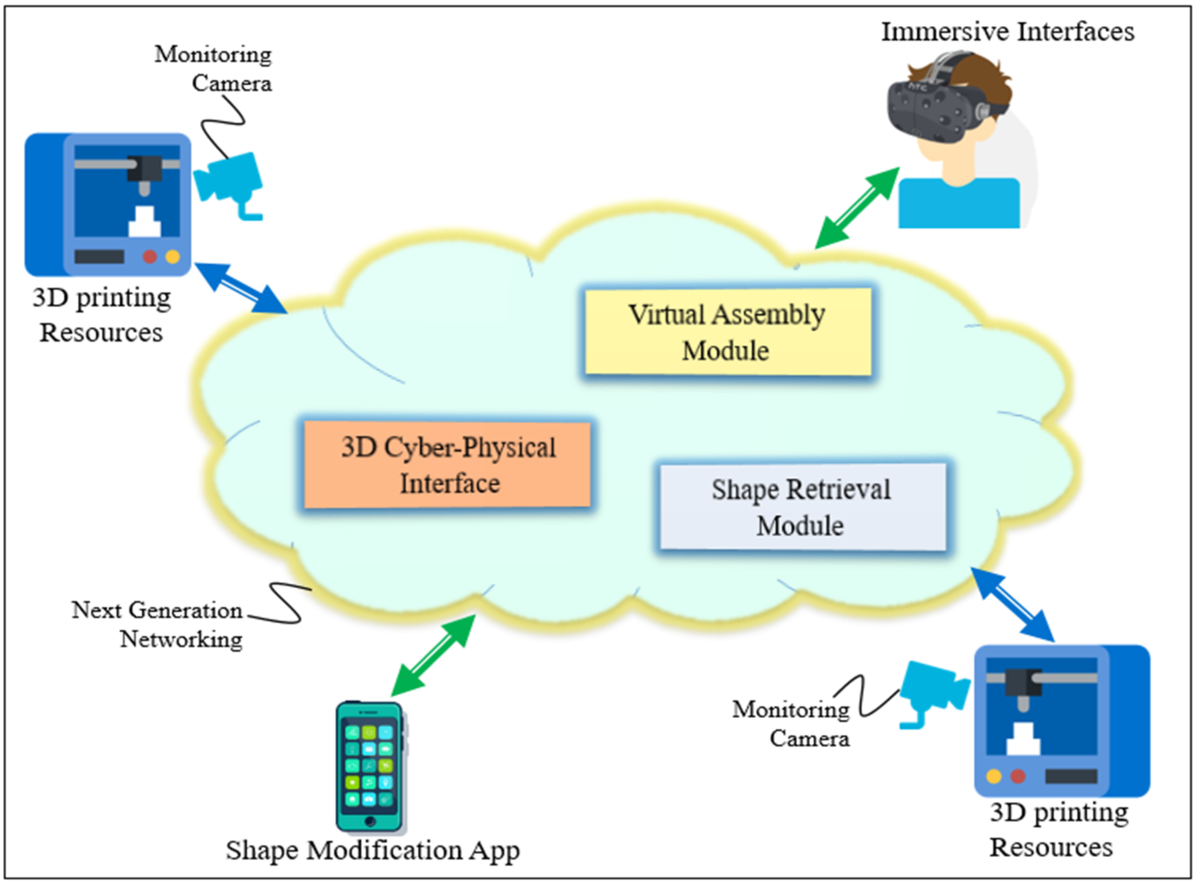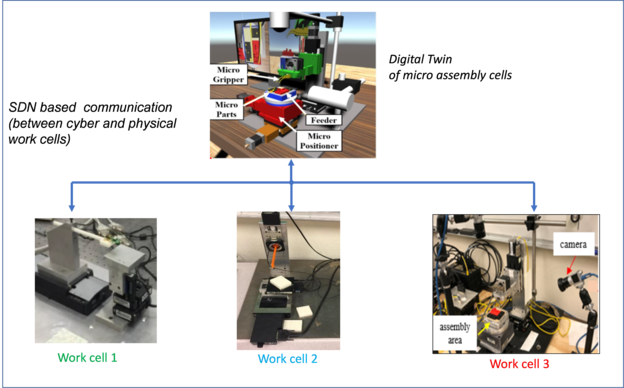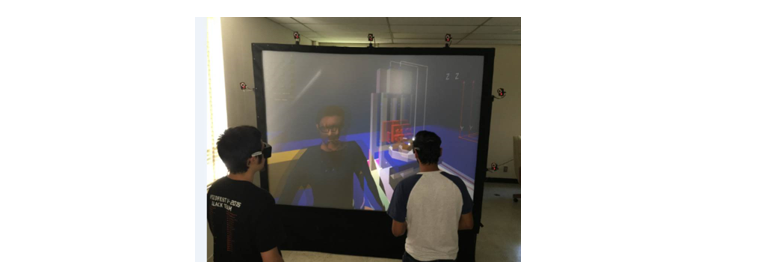Chronicle of our work in smart manufacturing and Industry 4.0
Smart Manufacturing is a term that can be used to encompass an array of principles, techniques and technologies that enable the realization and practice of information intensive, intelligent and integrated manufacturing practices as part of the Fourth Industrial Revolution. The term Industry 4.0 is used interchangeably with the fourth industrial revolution and represents a new era in industrial automation where the emphasis is on digital collaboration, integration and transformation. The role of information centric practices and technologies assumes predominance.
Dr. Cecil is one of the pioneers in the realm of smart manufacturing and Industry 4.0. His early work at the turn of this century recognized the information centric foundations for cyber manufacturing and the advent of the 4th industrial revolution. In the early 2000s, his seminal papers outlining a vision for information centric manufacturing practices delineated an unique perspective that underscored the need for advanced information centric practices (with 3 thrusts in modeling, simulation and exchange of data/information) as a foundation towards the realization of next generation cyber intensive manufacturing enterprises. Some of these principles were reflected in the underlying principles of Industry 4.0, which were drafted in 2011 by the German government. Dr. Cecil has continued his work in smart manufacturing and designed/implemented one of the first Industry 4.0 frameworks based on IoT principles and cyber-physical collaboration.
What is Industry 4.0?
Industry 4.0 (in German Industrie 4.0) can be described as a vision emphasizing digital transformation of manufacturing/production and related industries. The origins of this term lie in a 2011 German manufacturing report that sought to lay the foundations of making the German manufacturing industry more competitive ('Industrie 4.0’).
The original definition of Industry 4.0 refers to “the intelligent networking of machines and processes for industry with the help of information and communication technology”
Other reports have expanded this notion and describe it as “a name for the current trend of automation and data exchange in manufacturing technologies, including cyber-physical systems, the Internet of things, cloud computing and cognitive computing and creating the smart factory”.
The Fourth Industrial Revolution refers to the radical changes to the manner in which we work, live and interact due to the adoption and introduction of a range of digital technologies from 3D Virtual/Mixed Reality to Internet-of-Things (IoT) based data collection and response, from Artificial Intelligence based situational prediction to rapid responses to real time events. These so-called concepts, approaches and technologies can be viewed as providing a certain level of ‘smart’ attributes to the enterprises that adopt them. For manufacturing enterprises these heterogenous mix of principles, technologies and practices can be referred to as ‘smart manufacturing’. Such smart manufacturing principles and practices can range from using 3D digital Virtual Reality simulators to plan manufacturing operations, to controlling and monitoring manufacturing machines, work cells or even entire factories through IoT networks. At our Center, we classify such ‘smart’ characteristics in manufacturing into several categories that derive from our information centric engineering perspective that revolves around our triumvirate of Modeling, Simulation / Visualization and Exchange. This triumvirate of concepts can be viewed as subsets of interest that align with Industry 4.0 themes.
Modeling: smart principles include being able to rapidly model functional and process dependencies between cyber and physical resources collaborating to design and build products in broader Industry 4.0 contexts.
Simulation / Visualization: smart principles and tools that enable engineers to build 3D digital twins or mockups of various manufacturing capabilities at different levels of abstraction (machine, work cell, factory level or collection of factories.
Exchange: smart methods and tools that help the seamless exchange of data/information across heterogenous platforms and networked partners; this includes communication of commands and feedback responses between cyber and physical components, cyber to cyber modules as well as IoT based sensor feedback (tracking, monitoring, etc).
Internet-of-Things (IoT) and Cyber-Physical Systems (CPS) are two closely related fields which have the potential to impact the design and implementation of Industry 4.0 practices. IoT refers in general to a network (such as the ubiquitous Internet) connecting a related group of cyber components (for cyber-cyber communication/data sharing, etc) or cyber to physical components to achieve a certain engineering or other function. CPS broadly refers to the collaboration of cyber and physical components being used to support an engineering or other function. Together, they both play a key role in designing the next generation of collaborative approaches that seek to adopt Industry 4.0 principles. The importance of advanced networking technology assumes significance as it’s the vital communication link between various systems, services as well as an array of sensors, cyber modules and physical devices at various levels of abstraction in such industry 4.0 collaborative contexts.
The networking component needs to address not just the capabilities to control and provide data exchange with low latency but also needs to encompass cyber security, trust and privacy issues in support collaborative interactions among industry partners. Cecil’s group has explored the feasibility of emerging next generation Internet technologies including Software Defined Networking (SDN)
The 9 digital industrial technologies of importance in the context of Industry 4.0 (taken from https://www.i-scoop.eu/industry-4-0/)
The image below provides a vision of such an Industry 4.0 framework which links distributed cyber and physical resources. Note that each or some of the cyber or physical resources can be in a different location and belonging to a different engineering or manufacturing organization.
Our work has focused on emphasizing the design and the role of such 3D digital twins as a link between cyber (or virtual components/software, etc) and physical components (machines, work cells, factories including robots, material handling equipment). Our ultimate goal is to create a high fidelity simulated manufacturing environment where different ideas related to manufacturing and supporting functions can be proposed, compared, analyzed, modified and validated without having to perform any physical operations. In other words, this 3D digital world can be viewed as a 3D simulated twin of its physical counterpart (at corresponding or relevant levels of abstraction).
While several researchers have focused on the creation of digital twins, our research is more interested in the creation of the 3D digital twin. The general area of creating a digital twin is not new. In fact, one can argue that any simulation model (executed by a software program or module) is a digital twin for a given scope or context. That by itself is not a new idea. Industrial engineers have been working on process simulation using digital or software tools. By the simpler connotation of just digital twins, these research efforts of yesteryears can be referred to as digital twins. The work in Cecil’s group is looking over and beyond just a digital twin model and is more focused on the creation of 3D Virtual/Augmented and Mixed Reality (VR/AR/MR) environments which mimic or simulate the functioning in great detail of their corresponding physical manufacturing counterparts.
A vision of an IoT based cyber physical framework for manufacturing collaboration in the context of Industry 4.0
Two decades of Smart Manufacturing
A brief chronicle of the major milestones achieved by Dr. Cecil’s research group in the area of Smart Manufacturing follows.
2001- 2002: Early work: The information centric engineering perspective for smart manufacturing
Cecil proposes the information centric manufacturing perspective encompassing the triumvirate: modeling, simulation and exchange of information for smart manufacturing; he proposes the term virtual manufacturing and virtual manufacturing enterprises to describe the next generation of digital manufacturing approaches and practices.
2002 – 2008: Early work in Digital Twins: Design of digital twin based VR environments for micro devices assembly
- Cecil pioneers the role of 3D digital twins to enable better planning and control of virtual (cyber) -physical environments for the domain of micro devices assembly; the approach proposed was used to plan manufacturing process steps, study/modify alternatives and subsequently control manufacturing equipment for one automated work cell equipped with cameras, grippers and assembly areas. Camera based sensors enable tracking, part recognition and also provide feedback to the cyber-physical frameworks, which is created as part of a project funded by Sandia National Labs. One of the key aspects of this research is the importance of creating 3D digital twins (using Virtual Reality) to be used as a simulator to compare downstream alternatives as well as serve as vital link between cyber and physical resources.
- As part of another project funded by the Air Force Research Lab, Cecil’s team develops a smart manufacturing oriented concurrent engineering environment that functions as a Virtual Reality based digital twin to enable cross functional teams assess assembly, testing and launch issues early in the design cycle for small satellites. The approach is implemented to design, build and launch a satellite (called TechSat 21) for the Missile Defense Agency.
Left: A view of the VR based concurrent engineering environment created for small satellite product development; this served as a digital twin medium to support cross functional analysis from manufacturing, assembly, test and service perspectives;
Right: a view of one of the initial satellite designs created.
2006- 2008: Semantic framework for smart manufacturing
- Cecil’s research underscores the importance of addressing semantic bottlenecks in collaborative manufacturing; his team proposes a semantic web based approach to enable manufacturing and engineering partners function as a virtual enterprise using ontology based partner selection, manufacturing simulation and distributed control of manufacturing equipment for micro assembly processes.
- The earlier cyber-physical approach to manufacture micro devices was expanded to include an array of micro device work cells capable of assembling a variety of micro sensors and parts.
2009 – 2020:
- Industry 4.0 CPS Framework: Phase 1: 2009 – 2016: Cecil begins the formulation of an advanced Internet based cyber-physical approach which will allow engineers to rapidly assemble an array of micro sensors and devices using a combination of cyber (virtual) and physical components. As part of a combined NSF and US Ignite initiative, he develops an information centric, semantic web based approach that has an advanced Virtual Reality based digital twin environment, which serves as a link between distributed cyber and physical resources (components) for the domain of micro devices assembly. His research explores and demonstrates the feasibility of a new (at that time) principle referred to as Software Defined Networking (SDN) to reduce the latency and increase the bandwidth between communicating entities in the collaborative framework. The approach is validated involving three sites hosting cyber-physical resources in the US; the feasibility of the proposed IoT CPS framework in supporting realization of some of the Industry 4.0 objectives is further strengthened when micro devices are manufactured using the same approach and framework. This is one of the first comprehensive attempts at exploring such a complex cyber-physical framework in the field of advanced manufacturing. This milestone demonstration is recognized through Tech Demo awards at the 2013 and 2016 Global Environments for Network Innovation (GENI) and US Ignite workshops; Another unique aspect of his methodology is the design of physics based Virtual Reality environments that can serve as 3D digital twins and as the link between the cyber (virtual) components and physical manufacturing resources
- Industry 4.0 CPS Framework: Phase 2: 2016 – 2019: an extended collection of cyber components including algorithm based assembly planning (based on Genetic Algorithms, Insertion and A* algorithms) are introduced to mimic competing virtual enterprise partners; advanced tracking using information modeling approaches are introduced. Modeling of van der Waals forces to predict outcome of micro gripping is also incorporated.
An Industry 4.0 IoT Cyber-physical framework to support the assembly of micro devices
This framework was created to support the rapid and agile assembly of micro devices, using distributed cyber modules and linked using next generation networking. Planning, control and feedback among the cyber-physical components were achieved through a network of camera and controller sensors exchanging data and information through innovative Software Defined Networking (SDN) approaches. This groundbreaking research was funded as part of an NSF and US Ignite initiative.
Tracking and Monitoring of IoT devices in the Industry 4.0 Test Bed created at OSU
The IoT based cyber-physical interactions were supported through a multi-user SDN architecture
Data Traffic during the IoT interactions
The performance of IoT framework in supporting cyber-physical collaboration involving distributed locations and user interactions was also studied. Performance measurements of traffic was performed using GENI Desktop (see above data traffic diagram). The network latency between these multiple locations was measured using ICMP ping. As can be seen from the data traffic figure, the latency is stable at around 46 milliseconds. These experiments indicate the feasibility of the overall IoT network to support distributed interactions using the framework discussed in this paper.
This achievement of an Industry 4.0 milestone was recognized through two Tech Demo awards at the NSF GENI conferences held in Tempe, AZ (2013) and Washington, DC (2016). His earliest paper outlining this approach to plan, simulate and control robotic assembly devices for advanced manufacturing was published in 2004. His collection of papers in smart manufacturing, cyber-physical collaboration and control, industry 4.0 and related topics can be found on his professional and research gate profile
This collaborative framework evolved into an Industry 4.0 Test Bed. The first round of demonstrations of this Industry 4.0 test bed was conducted involving distributed groups of resources and engineers within the US in Tulsa, Stillwater (OK), El Paso (TX), Madison (WI) and Washington DC). The second phase of demonstrations involved cyber – physical interactions among partners in the US as well as France. The IoT based network was able to support the collaborative interactions which include assembly analysis, planning, control, assembly and feedback of the micro assembly activities. An assortment of micro sensors and designs were assembled using robotic sensor equipped work cells including micro stages, grippers, cameras, assembly stages. A closeup view of one of the micro assembly work cells and some of the micro assembly tasks in progress is shown below.
One of the robotic work cells in the IoT based cyber-physical test bed and framework
Images of some of the manufacturing tasks in progress resulting in the assembly of micro devices and sensors
Role of Digital Twins and Augmented Reality in Industry 4.0 test bed
Advanced Digital Twins of the target micro assembly environments were designed and created using Human Centered Computing (HCC) principles and Virtual/Augmented Reality technology. The role of such Augmented Reality technology as one of 9 core digital technologies has been recognized by Industry 4.0. In this approach, a user can propose and compare various micro assembly alternatives in an immersive 3D environment wearing a 3D headset. To interact directly with a remotely connected physical work cell, a user can also have access to an augmented view that can help guide them in controlling and interacting with a physical work cell. The images below illustrate this implementation in this Industry 4.0 Test Bed.
2018- present: Creation of a IoT supporting smart app for 3D printing
This project involves the design of an IoT cyber-physical app that can be run on smart phones to enable users to rapidly design and print 3D shapes. The overall objectives is to provide engineers, hobbyists and others in the Maker community to quickly create a 3D design from scratch without the need to use expensive CAD tools. Using a touch screen interface on a smart phone or tablet; a new design can be quickly created or an existing design can be modified; then they can be sent to a remote 3D printer through an IoT network, which also provides a camera view of the part being printed.
An IoT supporting smart app for 3D printing manufacturing contexts
Educational Activities
Dr. Cecil has been in the forefront of curriculum development and has created new courses relating to smart manufacturing and Industry 4.0. He has worked in both mechanical and industrial engineering departments where he taught courses in these topics beginning in 2002. His courses have always attracted an interdisciplinary group of undergraduate/graduate students in mechanical, manufacturing, industrial, electrical engineering and computer science, which reflects both the cyber-technology and manufacturing contexts of smart manufacturing. Recently, in 2016, he moved from Industrial Engineering to the department of Computer Science to co-direct the Center for Cyber-Physical Systems. He currently teaches ‘Introduction to Cyber-Physical Systems’ (senior/graduate level elective) focusing on CPS, IoT principles and techniques supporting realization of Industry 4.0 oriented collaborative practices. His second course ‘Modeling of Cyber-Physical Systems’ deals with teaching students on how to model and design such CPS approaches with an emphasis on robotic assembly and micro manufacturing processes. His courses emphasize theory, engineering methods and lab based software skills to prepare the next generation of engineers who can collaborate to support the realization of cyber-physical enterprises along the lines of Industry 4.0. Dr. Cecil is also known for his cyber learning approaches involving creation of 3D Virtual Reality based learning environments to support learning of smart manufacturing and other concepts. He was recently recognized (in Aug 2020) for his innovative education and mentoring work with the 2020 Presidential Award for Excellence in Science, Mathematics and Engineering Mentoring (PAESMEM). In 2015, he was recognized for his smart manufacturing work by the Institute of Industrial Engineers (IIE), who awarded him the National Technical Innovation award.
A state of the art teaching lab to support learning of smart manufacturing, CPS, IoT and Industry 4.0 concepts and practices has been setup by Dr. Cecil at OSU. Some of the images of student interactions and cyber-physical lab setups for learning experiences is provided below. The educational thrusts in this lab (part of the research center on CPS) have an unique emphasis on learning of smart manufacturing concepts including designing cyber-physical approaches for Industry 4.0 applications in various domains: advanced manufacturing, space systems and others.
A Cyber-Physical Lab setup for Industry 4.0 course modules: Students in the two CPS courses are exposed to smart manufacturing and Industry 4.0 concepts through software oriented lab experiences which exposes them to IoT and CPS concepts that can be applied to smart manufacturing; the cyber physical setup is shown above.
Industry 4.0 Lab Based Learning: Two of the students (above, seen wearing 3D eye-wear) in the Introduction to Cyber-Physical Systems course seen interacting with an avatar within a 3D VR digital twin environment, which can be linked to physical assembly work cells as part of Industry 4.0 learning experiences. The students can study various process alternatives for assembling micro devices, which are then communicated with physical work cells in the lab.
Our smart manufacturing and Industry 4.0 papers over the past 2 decades:
Refereed Publications in Journals and Books
(student co-authors are underlined)
- Cecil, J., Albuhamood, S., Ramanathan, P., Gupta, A., (2019), An Internet-of-Things (IoT) based cyber manufacturing framework for the assembly of micro devices, special issue on Smart Cyber Physical Systems, International Journal of Computer Integrated Manufacturing, April 2019, pp. 1-11.
- Cecil, J. (2018), A Collaborative Manufacturing Approach supporting adoption of IoT principles in Micro Devices Assembly, Procedia Manufacturing Journal, 26, 2018, pp. 1265-1277.
- Cecil, J., Albuhamood, S., Cecil-Xavier, A., Ramanathan, P., An Advanced Cyber Physical Framework for Micro Devices Assembly, Special Issue on “Advanced CPS for Industry 4.0 - Enabling Technologies, Real-world Implementations, and Impact Assessments”, IEEE Transactions on Systems, Man, and Cybernetics: Systems, August 2017, Issue 99, pp. 1-15
- Krishnamurthy, R., Cecil, J., A Next Generation IoT based Collaborative Framework for Electronics Assembly, International Journal of Advanced Manufacturing Technology, April 2018, Volume 96, Issue 1–4, 39–52.
- Lu, Y., Cecil, J., An Internet of Things (IoT) based collaborative framework for advanced manufacturing, International Journal of Advanced Manufacturing Technology, May 2016, Volume 84,5, pp 1141-1152.
- Panetto, H., Zdravkovic, M., Jardim-Goncalves, R., Romero, D., Cecil, J., Mezgar, I, New Perspectives for Future Interoperable Enterprise Systems", Computers in Industry, Special Issue: “Future Perspectives on Next Generation Enterprise Information Systems: Emerging Domains and Application Environments”, Vol 79, June 2016, pp. 47-63
- Cecil, J., Internet of Things (IoT) based Cyber Physical Frameworks for Advanced Manufacturing and Medicine, refereed chapter in book, Internet of Things (IoT) & Data Analytics Handbook, (editor: H. Geng), John Wiley & Sons, Jan 2017, pp. 545-556.
- Lu, Y., Cecil, J, An Internet of Things (IoT) based cyber physical framework for Advanced Manufacturing, On the Move to Meaningful Internet Systems, Lecture Notes in Computer Science 9416, Ioana Ciuciu, Hervé Panetto (Eds.), Springer Series, 2015, pp. 66- 74.
- Cecil, J, Jones, J., An Advanced Virtual Environment for Micro Assembly, International Journal of Advanced Manufacturing Technology, Vol.72, Issue 1, 2014, pp. 47-56.
- Panetto, H., and Cecil, J., Information systems for enterprise integration, interoperability and networking: theory and applications, Enterprise Information Systems, Vol 7, No. 1, pp.1-6, 2013.
- Cecil, J., Huber, J., Gobinath, N., Jacquess, J., A Virtual Factory Environment to support Process Design in micro assembly domains, Computer Aided Design and Applications, Volume 8 Number 1, 2011, Pages 119-127.
- Cecil, J., Narayanasamy, G., A Semantic Framework for Distributed Nano Assembly and Engineering, On The Move to Meaningful Internet Systems, Lecture Notes in Computer Science, 2010, Volume 6428/2010, pp. 249-256.
- Muthaiyan, A., Cecil, J., A Virtual Environment for Satellite Assembly, Computer Aided Design and Applications, Vol.5, Nos.1-4, 2008, pp. 526-538.
- Gobinath, N., Cecil, J., Powell, D., Micro Devices Assembly using Virtual Environments, Journal of Intelligent Manufacturing, Vol.18, No.3, June 2007, pp.361-369.
- Powell, D., Cecil, J. and Vasquez, D., Assembly and Manipulation of Micro Devices, Journal of Robotics and CIM, Vol.23, No. 5, October 2007, pp.580-589.
- Cecil, J., Kanchanapiboon, A., Virtual Engineering Approaches in product and process design, International Journal of Advanced Manufacturing Technology, Vol. 31, No. 9-10, January 2007, pp.846-850.
- Gobinath, N., Cecil, J., Son, T., A Collaborative System to realize Virtual Enterprises using 3APL, refereed paper in a book, Declarative Agent Languages and Technologies IV, Lecture Notes in Artificial Intelligence, Lecture Notes in Artificial Intelligence, Volume 4327,2006, pp 191-206.
- Cecil, J., Gobinath, N., Development of a Virtual and Physical Cell to assemble micro devices, Special Issue, Journal of Robotics and CIM, August-October 2005, pp.431-441.
- Cecil, J., Vasquez, D., A Review of Gripping and Manipulation Techniques for Micro Assembly Applications, International Journal of Production Research, Vol.43, No.4, 2005, pp.819-28.
- Bowers, J., , J., Internet based Frameworks for Virtual Enterprises, World Scientific and Engineering Academy and Society Transactions on Information Science & Applications, Issue 8, Vol. 3, August 2006, pp. 1601-1606.
- Cecil, J., et al, A Distributed Process Planning Framework for Prismatic Parts, International Journal of Advanced Manufacturing Technology, Volume 27, Numbers 5-6 , January 2006, pp. 619-624.
- Cecil, J., ‘Virtual Enterprises’, refereed paper in a book, The Internet Encyclopedia, 2003, Volume 3, pp. 567-578.
Editor and Refereed Book Chapters
- Panetto, H., Cecil, J. and Qing Li (Editors), On the Move to Meaningful Internet Systems: OTM 2011 Workshops, EI2N + NSF ICE 2011 International Workshop on Enterprise Integration, Interoperability and Networking + NSF Information Centric Engineering. Lecture Notes in Computer Science, 2011, Volume 7046/2011.
- Panetto, H., and Cecil, J., Editors, Special Issue on Enterprise Integration, Interoperability and Networking: Theory and Applications, Enterprise Information Systems, Vol 7, No. 2, 2013.
- Gusmeroli, S., Lazaro, O., Pazin, Z., Decubber, C., Pedrazzoli, P., Abeele, D., Piergiavanni, S., Cassina, J., Cerri, D., Terzi, S., Sola, J., Arconada, I., Fischer, K., Felic, A., Sesana, M., Sanguini, R., Huertas, L., Rotonadi, D., and Cecil, J., Industrial Internet of Things (IoT) and the Innovation Process, Building the Hyperconnected Society - IoT Research and Innovation Value Chains, Ecosystems and Markets (book),, 146 – 187, 2015, River Publishers Series in Communications, River Publishers (Denmark).
- Cecil, J., Huber, J., Virtual Prototyping in Engineering, chapter 1, Virtual Engineering (Book), pp. 1- 15, Momentum Press, Feb 2010, New Jersey.
- Cecil, J., editor, Virtual Engineering, Momentum Press, Feb 2010, New Jersey.
Refereed Conference Papers
- Cecil, J., Ramanathan, P., Huynh, H., A cloud-based cyber-physical framework for collaborative manufacturing, Proceedings of the 47th SME North American Manufacturing Research Conference, NAMRC 47, Erie, PA, June 10-14, 2019.
- Cecil, J., Krishnamurthy, R., and Gupta, A., Exploring Immersive Simulation based Design Frameworks in Support of the Moon Mission, Proceedings of the 13th Annual IEEE International Systems Conference, Orlando, Florida, April 8-11, 2019.
- Cecil, J., Cecil-Xavier, A. and Albuhamood, S., An Internet-of-Things (IoT) based framework for collaborative cyber physical tasks in micro assembly, Proceedings of the International Mechanical Engineering Congress & Exposition (IMECE), Pittsburgh, November 11-14 2018.
- Cecil, J., Albuhamood, S, Cecil-Xavier, A., An Industry 4.0 Cyber-Physical Framework for Micro Devices Assembly, Proceedings of 14th IEEE International Conference on Automation Science and Engineering (IEEE CASE), Munich, Germany, August 20-24, 2018.
- Cecil J., Albuhamood,, A Virtual Reality based Cyber Physical framework for micro devices assembly, Proceedings of the Twelfth International Symposium on Tools and Methods of Competitive Engineering (TMCE 2018), Las Palmas de Gran Canaria, Gran Canaria, Spain, May 7 – 11 2018.
- Krishnamurthy, R., Cecil, J., A next generation IoT framework for PCB assembly using cyber and physical resources, Proceedings of the 2018 Annual IEEE International Systems Conference (SysCon), Vancouver, Canada, April 23-26, 2018.
- Cecil, J., Cecil-Xavier, A., Gupta, A., Foundational Elements of Next Generation Cyber Physical and IoT Frameworks for Distributed Collaboration, Proceedings of the 2017 13th IEEE Conference on Automation Science and Engineering (CASE 2017), Xian, China, Aug 20 – 23.
- Krishnamurthy, R., Cecil, J., Perera, D., An Internet-of-Things based Framework for Collaborative Manufacturing, Proceedings of the 2017 International Mechanical Engineering Congress & Exposition, Miami, Florida, Nov 3-9, 2017.
- Cecil, J., Cecil-Xavier, A., Krishnamurthy, R. Emergence of Next Generation IoT based Cyber-Physical Frameworks for collaborative manufacturing, Proceedings of the 7th International Conference on Information Society and Technology (ICIST) 2017, Zdravković, M., Konjović, Z., Trajanović, M. (Eds.), Kopaonik, Serbia, March 12-15, 2017, 1, pp.251-256.
- Cecil, J., Gunda, R., Cecil-Xavier, A., A Next Generation Collaborative System for Micro Devices Assembly, Proceedings of 2017 Annual IEEE International Systems Conference (SysCon), April 24-27, Montreal, Canada.
- Cecil, J., Albuhamood, S., An Internet of Things based Cyber Physical Test Bed for Collaborative Manufacturing, Proceedings of the ASME 2016 International Mechanical Engineering Congress, Nov 11-17, Phoenix, AZ.
- Cecil, J., Albuhamood, S., An Integrated Collaborative Approach for Micro Devices Assembly, Proceedings of the 11th International Workshop on Enterprise Integration, Interoperability and Networking (EI2N), On the Move to Meaningful Internet Systems Confederated International Conferences: OTM 2016 Workshops, Rhodes, Greece, Oct 24- 28, 2016, Lecture Notes in Computer Science (LNCS) Vol 10034, 57-64.
- Lu, Y., Cecil, J., Mayfield, B., Ramanathan, P., A next generation IoT based approach for collaborative manufacturing, Proceedings of the 2016 Industrial and Systems Engineering Research Conference, Anaheim, CA, May 2016.
- Lu, Y., Cecil, J., Zafar, Z. The creation of Collaborative Cyber Physical Environments for Micro Assembly, Proceedings of the ASME 2015 International Mechanical Engineering Congress & Exposition, November 13-19, 2015, Houston, Texas.
- Lu, Y., Cecil, J., An Internet of Things (IoT) based Cyber Physical Framework for Advanced Manufacturing, 2015 Industry Case Studies Workshop, held in conjunction with CooPIS 2020, Oct 4-9, Rhodes, Greece.
- Cecil, J., Lu, Y., Raj Kumar, M.B., A Virtual Reality based simulation framework for advanced manufacturing, Proceedings of the 2015 Industrial and Systems Engineering Research Conference, May 2015, Nashville, TN.
- Ramisetty,, Calyam, P., Cecil, J., Amit Rama Akula, Ronny Bazan Antequera, Ray Leto, Ontology Integration for Advanced Manufacturing Collaboration in Cloud Platforms, 2015 IFIP/IEEE International Symposium on Integrated Network Management, May 11-15 2015, Ottawa, Canada.
- Cecil, J., Gunda, R., Calyam, P., Seetharam, S., A Next Generation Collaborative Framework for Advanced Manufacturing, Proceedings of the 9th annual IEEE International Conference on Automation Science and Engineering (IEEE CASE 2013), August 17 - 21, 2013, Madison, WI.
- Cecil, J., Information Centric Engineering (ICE) Frameworks for Advanced Manufacturing Enterprises, Proceedings of Industry Applications and Standard Initiatives for Cooperative Information Systems for Interoperable Infrastructure, OnTheMove Conferences, Sept 10, 2013, Graz, Austria.
- Berryman, P. Calyam, Cecil, J., G. Adams, D. Comer, “Advanced Manufacturing Use Cases and Early Results in GENI Infrastructure”, Proceedings of the Second GENI Research and Educational Experiment Workshop (GREE), 16th Global Environment for Network Innovations (GENI) Engineering Conference, Salt Lake City, March 19-21,2013.
- Gunda, R., Cecil, J., Calyam, and S. Kak, Information Centric Frameworks for Micro Assembly, International Workshop on Enterprise Integration, Interoperability and Networking + NSF Information Centric Engineering. Lecture Notes in Computer Science, 2011, Volume 7046/2011.
- Cecil, J., Gobinath, N., J. Long, H. Hartmann, A Semantic Framework for Distributed Nano assembly and engineering, presented at the 5th International Workshop on Enterprise Integration, Interoperability and Networking (EI2N’2010), Hersonissous, Crete, Greece October 27-28, 2010.
- Cecil, J., Huber, J., Gobinath, N., Jacques, J., A Virtual Factory Environment for micro assembly activities, presented at the 2010 CAD Conference, Dubai, UAE, June 21-25, 2010.
- Cecil, J., Gobinath, N., A Cyber Physical Test Bed for Collaborative Micro Assembly Engineering, presented at the Collaboration Technologies and Systems (CTS) 2010 conference, held in Chicago, May 17-21, 2010.
- Cecil, J., Gobinath, N., Virtual Reality based Prototyping Techniques in Product and Process design, Proceedings of 2009 Computer Aided Design conference, Reno, Nevada, June 8-12, 2009
- Cecil, J., Modeling the Process of Creating Virtual Prototypes, Proceedings of 2009 Computer Aided Design conference, Reno, Nevada, June 8-12, 2009.
- Cecil, J., Gobinath, N., Kanchanapiboon, A., A Virtual Test Bed for PCB Assembly, the 2008 Flexible Automation and Intelligent Manufacturing conference, June 30 – July 2, Skovde, Sweden.
- Muthaiyan, A., Cecil, J., A Virtual Test bed for the assembly of satellites, CAD 2008, June 23-27, Orlando, FL.
- Boettner, S., Cecil, J., Jiao, Y., An Advanced Collaborative Framework for micro devices assembly, the 2007 IEEE Conference on Automation Science and Engineering (CASE) Conference, Sept. 22-25, Scottsdale, AZ.
- Gobinath, N., Cecil, J., An Information Based Manufacturing framework for micro assembly, the 2006 IEEE Conference on Automation Science and Engineering (CASE) Conference, October 8-10, Shanghai, China
- Gobinath, N., Cecil, J., An Internet based framework for micro devices assembly, the ASME 2006 International Design Engineering Technical Conferences & Computers and Information in Engineering Conference, September 10-13, 2006, Philadelphia, PA.
- Cecil, J., Gobinath, N., On the Foundations of an Information Based Manufacturing framework for Micro Devices Assembly: A discussion on related needs, issues and design of a framework for implementation, the First 1st CIRP-International Seminar on Assembly Systems, 15-17 November 2006, Stuttgart, Germany
- Gobinath, N., Cecil, J., Son, T., A Collaborative System to realize Virtual Enterprises using 3APL, Proceedings of the 4th International Workshop on Declarative Agent Languages and Technologies (DALT 2006), Future University, Hakodate, Japan, May 8, 2006.
- Bowers, J., Cecil, J., Internet based Frameworks / Infrastructures for Virtual Manufacturing Enterprises: A Literature Review, Proceedings of the 4th WSEAS International Conference on System Science and Simulation in Engineering, Tenerife, Canaries Islands, Spain, December 2005.
- Gobinath, N., Cecil, J., Investigation of a framework for collaboration across heterogeneous domains, Proceedings of the 2005 Annual ASME Congress, November 5-11, Orlando, FL 2005.
- Trivedi, A., Cecil, J., An Information Based Manufacturing framework for Nano assembly, Proceedings of the 4th WSEAS International Conference on System Science and Simulation in Engineering, Tenerife, Canaries Islands, Spain, December 2005.
- Cecil, J., Gobinath, N., A Semantic Web based Framework for Micro Devices Assembly, Proceedings of the 2005 Flexible Automation and Integrated Manufacturing Conference, Bilbao, Spain, July 17-20, 2005.
- Vasquez, D., Cecil, J., Shashikanth, , Investigation of van der Waals Forces in the assembly of Micro Devices, Proceedings of the Industrial Engineering Research Conference, Atlanta, GA, May 14-18 2005.
- Cecil, J., Gobinath, N., Mobile agent and semantic web based frameworks for the creation of virtual manufacturing enterprises, Proceedings of the 2004 ASME Annual Congress, Anaheim, CA, November 16 -19, 2004
- Cecil, J., Gobinath, N. VIRAM: A virtual reality environment for the assembly of micro devices, Proceedings of the 2004 ASME CIE (DETC) Conference, to be held in Salt Lake City, October 2004.
- Cecil, J., Micro and Nano Assembly, 2004 National Nanotechnology Initiative Grand Challenge Workshop, Palo Alto, CA, August 22-25, 2004 (paper was part of an overall Nanoscale Science, Engineering and Technology (NSET) subcommittee report submitted to the President's Council of Advisors on Science and Technology PCAST).
- Cecil, J., Gobinath, N, Design of Virtual Prototyping Environments using an Information Modeling Language, Proceedings of the 2004 Annual Industrial Engineering Research Conference (IERC), Houston, TX, May 16-18, 2004.
- Cecil, J., Powell, D., Vasquez, D., An Integrated Virtual and Physical Environment to study the assembly of micro devices, Proceedings of the 2004 Flexible Automation and Integrated Manufacturing Conference (FAIM), Toronto, Canada, July 12-14, 2004.
- Cecil, J., Powell, D., Assembly of Micro devices, Proceedings of the 2004 Annual Industrial Engineering Research Conference (IERC), Houston, TX, May 16-18, 2004.
- Cecil, J., 2003, A Virtual Prototyping Environment for the Assembly of Nanosatellites, published in the Proceedings of the IIE Annual Research Conference, May 17-21, Portland, Oregon
- Cecil, J., 2003, An Internet based Framework for product development activities, published in the Proceedings of the IIE Annual Research Conference, May 17-21, Portland, Oregon.
- Cecil, J., Kanchanapiboon, A., 2002, A Virtual Prototyping Framework for Electronics Manufacturing, Proceedings of the 2002 International Mechanical Engineering Congress, New Orleans, Nov. 17-22, 2002.
- Cecil, J., Kanchanapiboon, A., Kanda, P., Muthaiyan, A., ‘A Virtual Prototyping Test bed for Electronics Assembly, Proceedings of the 27th Annual IEEE International Electronics Manufacturing Technology (IEMT) symposium, San Jose, July 17-18, 2002, pp.130-136.


